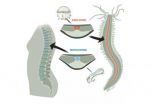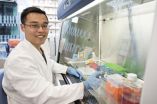(Press-News.org) Porcine neonatal coccidiosis is a serious parasitic infection of young piglets that severely damages the intestinal mucosa, leading to diarrhoea and reduced nutritional intake. As the infection reduces animal growth, and because secondary infections can result in increased mortality, the disease is responsible for substantial economic losses at affected pig farms.
"The developing immune system of neonatal piglets is not yet mature enough to deal with the parasites. For this reason, an infection shortly after birth results in weakened intestinal tissue with appropriate consequences. By comparison, Cystoisospora suis is absolutely harmless for adult pigs and their mature immune systems," explains first author Simone Gabner.
Immune cells grow more quickly in the intestines of infected piglets than in healthy ones
Scientists from the Institute of Parasitology at the Vetmeduni Vienna investigated how the developing immune system of piglets responds to an infection with Cystoisospora suis. For the purpose of the study, 25 animals aged three days were infected and observed in comparison with another 26 healthy, non-infected animals. The researchers analysed various different immune cells in the intestines of both groups over the course of the first days of life. High levels of so-called gamma delta T cells, a type of cell that recognizes tissue damage and activates the immune system, were found in infected piglets as early as four days after infection. Cytotoxic T-cells were detected eleven days after an infection. These are responsible for the cell death of infected cells and appear to have an immunologic memory function with regard to porcine neonatal coccidiosis.
Both types of T cells were detected significantly earlier in infected piglets than in non-infected animals. In healthy piglets, the T cells begin to settle in the intestine from about the third week of life.
"Before this, we didn't know which T cells played a part in porcine neonatal coccidiosis. Now we also know at which point they appear in the course and development of the disease. Their exact role in the intestines of the animals, however, remains unclear," Gabner says. "Cystoisospora suis affects epithelial cells in the intestine and destroys the natural barrier against pathogens. This makes secondary infections likely. We still don't know whether the T cells reduce the overall damage to the intestinal mucosa or if they perhaps cause the damage to the intestinal cells."
Innate immune system activated
Gabner and her colleagues also researched various receptors of the innate immune system in the piglets as well as signalling substances which play a part in the inflammatory response. Just four days after infection, the researchers found increased expression of certain pathogen receptors (TLR-2 and NOD2) and signalling molecules involved in inflammatory reactions (TNF-α) in the intestine of the infected animals. The parasite thus triggers the activation of the immune system. "Our research shows which signalling pathways could be involved. The immune response possibly begins even earlier. This is something to be investigated in future studies. We are one step closer to better understanding the disease," says Gabner.
Mother's milk a source of protection
Previous studies by the research group showed that protective antibodies against porcine neonatal coccidiosis are transferred to the piglets through the sow's milk directly after birth. Sows that had been exposed to the pathogen produced the respective antibodies from which the piglets could then benefit. In a follow-up study, the researchers went one step further. They deliberately infected sows with the parasites during gestation in order to increase the antibody levels in the maternal animals. The aim was to supply the piglets with as many antibodies from the mother's milk during their first days of life as possible. This "milk vaccination" was a success. The piglets of infected sows exhibited a less severe development of the disease than piglets of non-infected sows. The more antibodies a sow transferred to its piglets, the weaker the symptoms exhibited by the piglets.
INFORMATION:
Service:
The article „Immune response to Cystoisospora suis in piglets: local and systemic changes in T-cell subsets and selected mRNA transcripts in the small intestine", by Simone Gabner, H. L. Workiczek, K. Witter, F.R.L. Meyer, W. Gerner and A. Joachim was published in the Journal Parasite Immunology. DOI: 10.1111/pim.12116
About the University of Veterinary Medicine, Vienna
The University of Veterinary Medicine, Vienna in Austria is one of the leading academic and research institutions in the field of Veterinary Sciences in Europe. About 1,200 employees and 2,300 students work on the campus in the north of Vienna which also houses five university clinics and various research sites. Outside of Vienna the university operates Teaching and Research Farms. http://www.vetmeduni.ac.at
Scientific Contact:
Dr Simone Gabner
Institute of Parasitology
University of Veterinary Medicine Vienna (Vetmeduni Vienna)
T +43 1 25077-3402
simone.gabner@vetmeduni.ac.at
Released by:
Heike Hochhauser
Public Relations
University of Veterinary Medicine Vienna (Vetmeduni Vienna)
T +43 1 25077-1151
heike.hochhauser@vetmeduni.ac.at
Piglet health
A better understanding of the immune response to intestinal parasites
2014-09-12
ELSE PRESS RELEASES FROM THIS DATE:
Moving silicon atoms in graphene with atomic precision
2014-09-12
Richard Feynman famously posed the question in 1959: is it possible to see and manipulate individual atoms in materials? For a time his vision seemed more science fiction than science, but starting with groundbreaking experiments in the late 1980s and more recent developments in electron microscopy instrumentation it has become scientific reality. However, damage caused by the electron beam is often an issue in such experiments.
The present study focused on single-layer graphene with silicon atoms embedded into the lattice, previously created and studied by the collaborators ...
Cutting the cloud computing carbon cost
2014-09-12
Cloud computing involves displacing data storage and processing from the user's computer on to remote servers. It can provide users with more storage space and computing power that they can then access from anywhere in the world rather than having to connect to a single desktop or other computer with its finite resources. However, some observers have raised concerns about the increased energy demands of sustaining distributed servers and having them up and running continuously, where an individual user's laptop might be shut down when it is not in use or the resources utilization ...
From worm muscle to spinal discs
2014-09-12
Thoughts of the family tree may not be uppermost in the mind of a person suffering from a slipped disc, but those spinal discs provide a window into our evolutionary past. They are remnants of the first vertebrate skeleton, whose origins now appear to be older than had been assumed. Scientists at the European Molecular Biology Laboratory (EMBL) in Heidelberg, Germany, have found that, unexpectedly, this skeleton most likely evolved from a muscle. The study, carried out in collaboration with researchers at the Howard Hughes Medical Institute in Janelia Farm, USA, is published ...
New family of materials for energy-efficient information storage and processing
2014-09-12
Switching the polarity of a magnet using an electric field (magnetoelectric memory [MEM] effect), can be a working principle of the next-generation technology for information processing and storage. Multiferroic materials are promising candidates for the MEM effect, due to the coexistence of electric and magnetic orders. On the other hand, the coexistence of spontaneous electric and magnetic polarizations is rare in known materials, which hinders the application potential of the MEM effect. This article briefly reviews a new family of multiferroic materials—hexagonal rare ...
Conjecture on the lateral growth of Type I collagen fibrils
2014-09-12
Whatever the origin and condition of extraction of type I collagen fibrils, in vitro as well as in vivo, the radii of their circular circular cross sections stay distributed in a range going from 50 to 100 nm for the most part of them. Jean Charvolin and Jean-Francois Sadoc from the solid state physique laboratory at the Paris-Sud University propose therefore that, once the growth of the fibrils has been triggered by external biological factors, their lateral size be limited by internal physical stresses generated during the growth. Their conjecture is based ...
Extension of standard model by knot algebra
2014-09-12
This paper makes a connection between the quantum group SLq(2), which described knots, and the elementary particles of the standard model. The elements of the fundamental (j = 1/2) representation of SLq(2) are interpreted as creation operators for preons. The preons interact through a preonic vector field defined by elements of the adjoint (j = 1) representation. The leptons and quarks then appear (as required by the electroweak data) as elements of the j = 3/2 representation. Unexpectedly the electroweak quantum numbers of the so defined preons, leptons, and quarks agree ...
Scientists show that nicotine withdrawal reduces response to rewards across species
2014-09-12
Cigarette smoking is a leading cause of preventable death worldwide and is associated with approximately 440,000 deaths in the United States each year, according to the U.S. Centers for Disease Control and Prevention, but nearly 20 percent of the U.S. population continues to smoke cigarettes. While more than half of U.S. smokers try to quit every year, less than 10 percent are able to remain smoke-free, and relapse commonly occurs within 48 hours of smoking cessation. Learning about withdrawal and difficulty of quitting can lead to more effective treatments to help smokers ...
Favoritism linked to drug use in 'disengaged' families
2014-09-12
Before you revive the debate about which sibling in your family is the favorite, you'll want to know what the latest research shows.
Brigham Young University professor Alex Jensen analyzed 282 families with teenage siblings for a study that appears in the Journal of Family Psychology. Favoritism in parenting is a complex topic for sure, but here are some important take-aways.
Does it really matter?
Yes, at least for some families. Jensen looked at perceived preferential treatment in different types of family dynamics. For families that aren't very close to each other ...
Brain inflammation dramatically disrupts memory retrieval networks, UCI study finds
2014-09-12
Irvine, Calif., Sept. 10, 2014 — Brain inflammation can rapidly disrupt our ability to retrieve complex memories of similar but distinct experiences, according to UC Irvine neuroscientists Jennifer Czerniawski and John Guzowski.
Their study – which appears today in the Journal of Neuroscience – specifically identifies how immune system signaling molecules, called cytokines, impair communication among neurons in the hippocampus, an area of the brain critical for discrimination memory. The findings offer insight into why cognitive deficits occurs in people undergoing chemotherapy ...
No innocent bystander: Cartilage contributes to arthritis
2014-09-12
Melbourne researchers have discovered that cartilage plays an active role in the destruction and remodelling of joints seen in rheumatoid arthritis, rather than being an 'innocent bystander' as previously thought.
Dr Tommy Liu, Professor Ian Wicks, Dr Kate Lawler, Dr Ben Croker and colleagues from the Walter and Eliza Hall Institute made the discovery while investigating the role of the protein SOCS3 in controlling inflammation during rheumatoid arthritis. The study was published in the journal Arthritis and Rheumatology.
Rheumatoid arthritis affects more than 400,000 ...
LAST 30 PRESS RELEASES:
Stress sensitivity makes suicidal thoughts more extreme and persistent among the university population
Lessons from Ascension’s shark troubles could help boost conservation
Fire provides long-lasting benefits to bird populations in Sierra Nevada National Parks
Menstrual cycle affects women’s reaction time but not as much as being active
Housing associations more effective than government in supporting unemployed in deprived areas
Biochar helps composting go greener by cutting greenhouse gas emissions
Ulrich named president-elect of the AACI
Multitasking makes you more likely to fall for phishing emails
Researchers solve model that can improve sustainable design, groundwater management, nuclear waste storage, and more
Parched soils can spark hot drought a nation away
Uncovering new physics in metals manufacturing
Sped-up evolution may help bacteria take hold in gut microbiome, UCLA-led research team finds
The dose-dependent effects of dissolved biochar on C. elegans: Insights into the physiological and transcriptomic responses
New research reveals genetic link to most common pediatric bone cancer
Research conducted during 2024 eclipse reveals importance of light on bird behavior
Why does female fertility decline so fast? The key is the ovary
Total solar eclipse triggers dawn behavior in birds
Europe’s largest bats hunt and eat migrating birds on the wing, high in the sky
China’s emerging AI regulation could foster an open and safe future for AI
The secret to naked mole-rat’s longevity: Enhanced DNA repair
Acidic tumor environment promotes survival and growth of cancer cells
New biosensor tracks plants’ immune hormone in real time
New study finds gaps in REDD+ forest carbon offsets with most overstating climate impacts
Mystery solved: How Europe’s largest bat catches and eats passerines mid-air
Pan-disease atlas maps molecular fingerprints of health, disease and aging
New clinical trial to target cancer’s elusive growth switch
Ochsner Health launches Genetic Wellness Assessment to identify cancer risks early
Researchers find potential link between chronic pain, immune condition
A study by UPF reveals discrimination on grounds of ethnic background in Spain’s leading online second-hand marketplace, especially when buying
Research examines the good, bad and ugly of true crime media
[Press-News.org] Piglet healthA better understanding of the immune response to intestinal parasites





